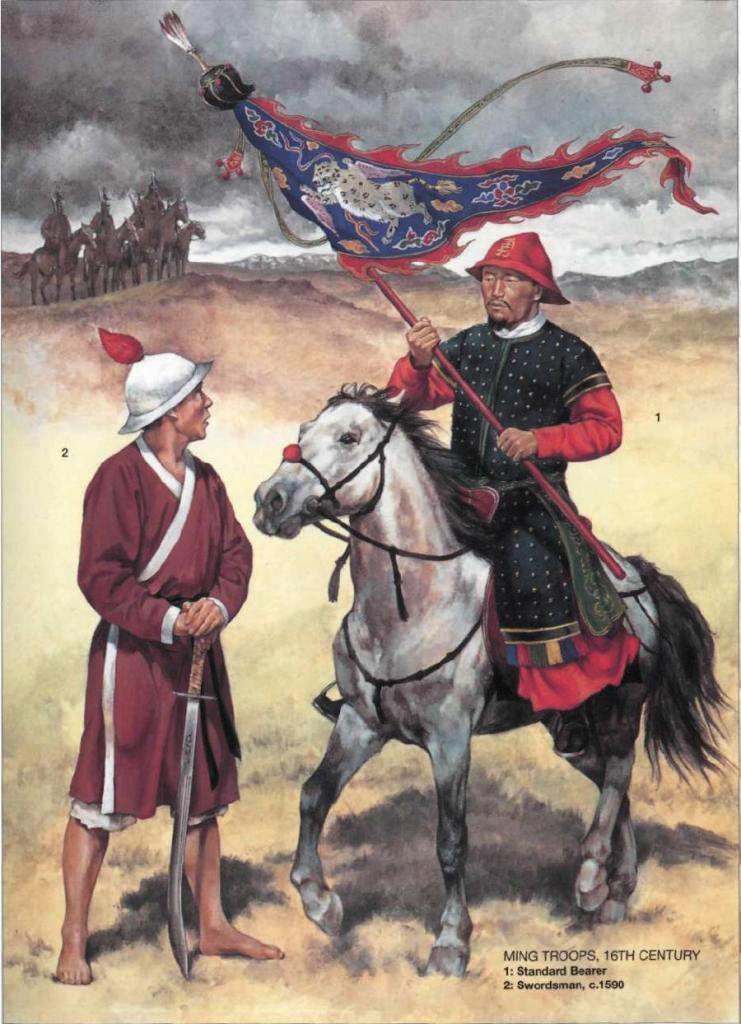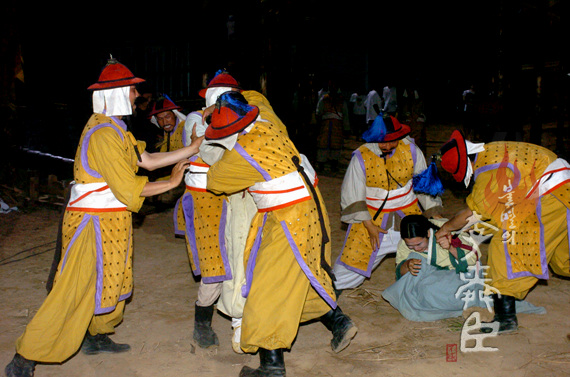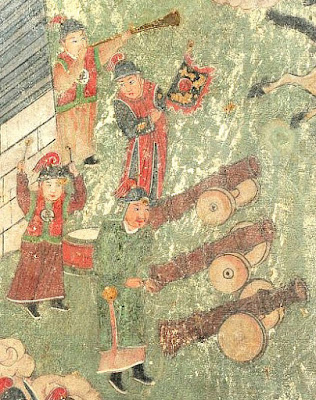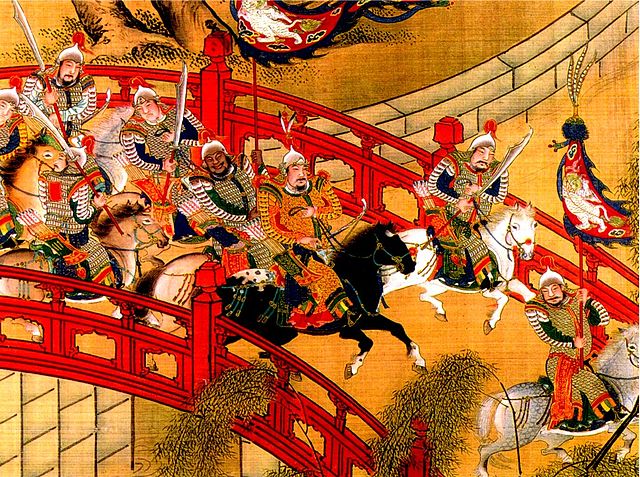I've posted this before, but now with the sneak preview of Asian ship models I know that East Asia is going to be touched on soon and I want to at least get my idea out to the devs.
Currently Ming enjoys having unique unit models compared to its neighbors, but they are somewhat inaccurate in their depiction of Ming Dynasty soldiers. I am hoping that they will be reworked in an upcoming expansion, or even have better models released for them.
I will divide my ramblings into sections to better organize this thread.
I. Tier 1 Unit
II. Tier 2 Unit
III. Tier 3 Unit
IV. Tier 4 Unit
V. Possible Cavalry Models
These are just my ideas for a more accurate portrayal of Ming soldiers. Tell me your thoughts and comments below
Currently Ming enjoys having unique unit models compared to its neighbors, but they are somewhat inaccurate in their depiction of Ming Dynasty soldiers. I am hoping that they will be reworked in an upcoming expansion, or even have better models released for them.
I will divide my ramblings into sections to better organize this thread.
I. Tier 1 Unit
The first tier sprite used in game looks like this

As you can see, the soldier is wearing lamellar armor, which was common in the early Ming period but already being replaced by brigadine during the start of EUIV. However the type of lamellar shown isn't accurate as an overall depiction of the Ming army.
Leather lamellar would have been worn by militia units in Southern China, where soldiers weren't given any priority in receiving new equipment as they weren't the ones defending against nomadic invaders.
Most Ming lamellar armor was made out of steel plates, and even then most were worn by cavalrymen and generals. However in the early Ming period more elite footsoldiers would have worn lamellar as well.
The helmet worn by the soldier is also something worn by an early Imperial guard, only deformed and looking very derpy compared to the real thing.


I doubt that every single Ming regiment was an imperial guard, so this model would not have been too accurate.
Final Verdict
A more accurate depiction of a Ming soldier from this time period would have looked like this. This was near the early middle part of the Dynasty, where Song-style armor had been greatly replaced by more conventional designs.





As you can see, the soldier is wearing lamellar armor, which was common in the early Ming period but already being replaced by brigadine during the start of EUIV. However the type of lamellar shown isn't accurate as an overall depiction of the Ming army.
Leather lamellar would have been worn by militia units in Southern China, where soldiers weren't given any priority in receiving new equipment as they weren't the ones defending against nomadic invaders.
Most Ming lamellar armor was made out of steel plates, and even then most were worn by cavalrymen and generals. However in the early Ming period more elite footsoldiers would have worn lamellar as well.
The helmet worn by the soldier is also something worn by an early Imperial guard, only deformed and looking very derpy compared to the real thing.


I doubt that every single Ming regiment was an imperial guard, so this model would not have been too accurate.
Final Verdict
A more accurate depiction of a Ming soldier from this time period would have looked like this. This was near the early middle part of the Dynasty, where Song-style armor had been greatly replaced by more conventional designs.




II. Tier 2 Unit
The in game model for a Ming soldier in the 1500-1600s looks like this, which is somewhat accurate.

However there are still a few inaccuracies with this depiction.
The average Ming infantryman of the era would have looked like this. At this time brigandine became the standard issue armor, and along with it brimmed hats and helmets.




The helmet worn by the in game model seems to try to mimic the brimmed helmet used by Ming soldiers, however, the brim is too small.
The most common color of brigandine was blue, with the most common uniform being red underneath. The in game model has this reversed, although it is still technically accurate (but rare).
Final Verdict
The model on the most part is fine, with the exception of the helmet. Either widen its brim or replace it with a brimmed hat.
Also it would be more favorable to reverse the colors of the armor and clothing underneath, as blue over red was the most common combination.


However there are still a few inaccuracies with this depiction.
The average Ming infantryman of the era would have looked like this. At this time brigandine became the standard issue armor, and along with it brimmed hats and helmets.




The helmet worn by the in game model seems to try to mimic the brimmed helmet used by Ming soldiers, however, the brim is too small.
The most common color of brigandine was blue, with the most common uniform being red underneath. The in game model has this reversed, although it is still technically accurate (but rare).
Final Verdict
The model on the most part is fine, with the exception of the helmet. Either widen its brim or replace it with a brimmed hat.
Also it would be more favorable to reverse the colors of the armor and clothing underneath, as blue over red was the most common combination.

III. Tier 3 Unit
The current tier 3 unit for Ming is in the middle of being accurate and inaccurate.

It depicts a footsoldier wearing a brown tabard and a Manchurian style hat.
The biggest inaccuracy here is the hat itself. The Ming Dynasty never adopted Manchurian clothing, as the Manchus were seen as barbarians, the same as their Mongol cousins, while the Chinese saw themselves as culturally superior to everyone else.
Manchurian culture was FORCED upon the Chinese after the establishment of the Manchu Qing Dynasty, with severe resistance from this policy having to be dealt with (whole cities were slaughtered for refusing to comply). The ancient Chinese were very defensive and proud of their culture (as stated above).
The Ming would never adopt anything that looked even remotely Manchu, especially since doing so would be taken as a sign of submission or defeat (bad if you're trying to prove your legitimacy while fighting for the throne of China against barbarian conquerors). The Ming Dynasty fought to the end, and with soldiers who looked like this.



It depicts a footsoldier wearing a brown tabard and a Manchurian style hat.
The biggest inaccuracy here is the hat itself. The Ming Dynasty never adopted Manchurian clothing, as the Manchus were seen as barbarians, the same as their Mongol cousins, while the Chinese saw themselves as culturally superior to everyone else.
Manchurian culture was FORCED upon the Chinese after the establishment of the Manchu Qing Dynasty, with severe resistance from this policy having to be dealt with (whole cities were slaughtered for refusing to comply). The ancient Chinese were very defensive and proud of their culture (as stated above).
The Ming would never adopt anything that looked even remotely Manchu, especially since doing so would be taken as a sign of submission or defeat (bad if you're trying to prove your legitimacy while fighting for the throne of China against barbarian conquerors). The Ming Dynasty fought to the end, and with soldiers who looked like this.


In reality, the Ming military in the Dynasty's final decade hadn't changed much for the past century, with soldiers wearing the same uniforms and armor as they had in the Tier 2 era.
However, if the Ming Dynasty had survived its downfall in the mid 1600s, I am confident to state that their soldiers would have looked like what is depicted in the Chinese drawing above. The brimmed hat was the common military hat for the Ming Dynasty, probably a more common sight among footsoldiers than helmets! Since armor has become obsolete by the 1700s, the brimmed hat would have replaced all helmets (except ceremonial and probably cavalry helmets) in military service.
The tabard was also common among Ming soldiers, although never brown like in the current unit model. They would have replaced brigandine armor (as armor has become obsolete) and would have been found colored blue, red, yellow, and/or green, with the last two being rare as base colors.

Final Verdict
Replace the Manchu hat with a brimmed hat, and recolor the tabard to another color (blue would be preferable) and you have yourself an accurate prediction of what a Ming soldier would have looked like in the 1700s.
However, if the Ming Dynasty had survived its downfall in the mid 1600s, I am confident to state that their soldiers would have looked like what is depicted in the Chinese drawing above. The brimmed hat was the common military hat for the Ming Dynasty, probably a more common sight among footsoldiers than helmets! Since armor has become obsolete by the 1700s, the brimmed hat would have replaced all helmets (except ceremonial and probably cavalry helmets) in military service.
The tabard was also common among Ming soldiers, although never brown like in the current unit model. They would have replaced brigandine armor (as armor has become obsolete) and would have been found colored blue, red, yellow, and/or green, with the last two being rare as base colors.

Final Verdict
Replace the Manchu hat with a brimmed hat, and recolor the tabard to another color (blue would be preferable) and you have yourself an accurate prediction of what a Ming soldier would have looked like in the 1700s.
IV. Tier 4 Unit
Currently, most East Asian countries have unit models that only go up to tier 3, with the exception of DLC content pack nations.
The clothing and fashion of China during the early 1800s was extremely different than it was in 1650, because at this time the Qing Dynasty had ruled China for 150 years already, and their clothing had been accepted by the rest of China.
However, in a universe where the Ming dynasty survived, hanfu would had still been the prominent style of clothing in China (or at least in the lands that the Ming Dynasty controlled). I doubt that if the Qing also coexisted alongside the Ming, that Ming culture would have slowly assimilated to become Manchu as well, due to the fact Joseon Korea (although invaded and conquered by the Manchus twice during the Ming downfall) had remained a Qing vassal and still looked like it was in the 1650s in the early 1800s.
In the real life Qing dynasty, their uniform for a standard unarmored footman in the 1700s was no different than that of a standard footman in the Boxer Rebellion. With this in mind, we can assume the same for the Ming dynasty.
That being said, there would not be many differences between the Tier 3 model and Tier 4 model, besides probably a more elaborate uniform.
Final Verdict
Not much would change, besides maybe a more elaborate uniform, such as embroidered clothing and a fancier brimmed hat.
It would be appropriate to reuse the Tier 3 model but with a flintlock musket and a cartridge bag instead of matchlock and individual cartridges on the belt.
The clothing and fashion of China during the early 1800s was extremely different than it was in 1650, because at this time the Qing Dynasty had ruled China for 150 years already, and their clothing had been accepted by the rest of China.
However, in a universe where the Ming dynasty survived, hanfu would had still been the prominent style of clothing in China (or at least in the lands that the Ming Dynasty controlled). I doubt that if the Qing also coexisted alongside the Ming, that Ming culture would have slowly assimilated to become Manchu as well, due to the fact Joseon Korea (although invaded and conquered by the Manchus twice during the Ming downfall) had remained a Qing vassal and still looked like it was in the 1650s in the early 1800s.
In the real life Qing dynasty, their uniform for a standard unarmored footman in the 1700s was no different than that of a standard footman in the Boxer Rebellion. With this in mind, we can assume the same for the Ming dynasty.
That being said, there would not be many differences between the Tier 3 model and Tier 4 model, besides probably a more elaborate uniform.
Final Verdict
Not much would change, besides maybe a more elaborate uniform, such as embroidered clothing and a fancier brimmed hat.
It would be appropriate to reuse the Tier 3 model but with a flintlock musket and a cartridge bag instead of matchlock and individual cartridges on the belt.
V. Possible Cavalry Models
Currently a few European and Muslim nations have their own unique cavalry models as well, if Ming were to ever receive a cavalry DLC this would be the most accurate progression.
Tier 1


Already seen it, you get the point.
Tier 2


Red brigandine armor was used by "light" cavalry of the period, with "heavy" lamellar wearing cavalry becoming less common.
Tier 3
Either the same as above only without the scale armor on the limbs, or wearing what the Tier 3 infantry would wear but with a cavalry helmet.
In the real life Qing dynasty, although armor became obsolete, brigandine remained in fashion among cavalry and generals, with the metal plating underneath removed. Basically it became an oversized tabard that's studded with metal.
Tier 4
Same as Tier 3, possibly with a more elaborate uniform. Unless it goes from faux brigandine to tabard. Another possible change could also be wearing a brimmed hat instead of helmet.

This is a Ming cavalryman without his armor. Basically like an off duty soldier wearing a patrol cap instead of a helmet and his blouse without his plate carrier. The tier 3 and 4 models could be based off him (only with a tabard).
Tier 1


Already seen it, you get the point.
Tier 2


Red brigandine armor was used by "light" cavalry of the period, with "heavy" lamellar wearing cavalry becoming less common.
Tier 3
Either the same as above only without the scale armor on the limbs, or wearing what the Tier 3 infantry would wear but with a cavalry helmet.
In the real life Qing dynasty, although armor became obsolete, brigandine remained in fashion among cavalry and generals, with the metal plating underneath removed. Basically it became an oversized tabard that's studded with metal.
Tier 4
Same as Tier 3, possibly with a more elaborate uniform. Unless it goes from faux brigandine to tabard. Another possible change could also be wearing a brimmed hat instead of helmet.

This is a Ming cavalryman without his armor. Basically like an off duty soldier wearing a patrol cap instead of a helmet and his blouse without his plate carrier. The tier 3 and 4 models could be based off him (only with a tabard).
These are just my ideas for a more accurate portrayal of Ming soldiers. Tell me your thoughts and comments below
- 7
- 2
Upvote
0

